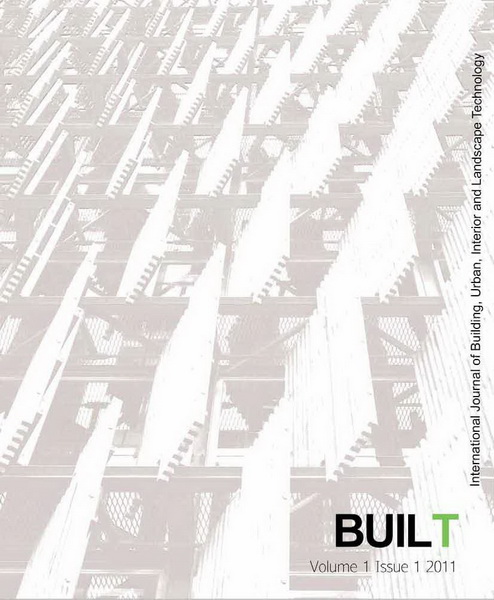The Physical and Thermal Properties of Adobe Brick Containing Bagasse for Earth Construction
DOI:
https://doi.org/10.56261/built.v1.170319Keywords:
Earth construction, Adobe brick, Bagasse, Rice husk, Strength, Thermal propertyAbstract
A form of natural architecture built with environmentally friendly materials, earth construction provides indoor protection from outside temperature conditions. In Thailand, adobe brick that contains rice husk is the most widely used material in earth construction. It is important to consider the strength and moisture absorption capacity of adobe brick. This research focuses on the feasibility of using agricultural by-products such as rice husk and bagasse in adobe brick mixtures with a percentage replacement of 0, 1, 2, 3 and 6% by weight of materials. The study explores the level at which replacing rice husk and bagasse in adobe brick effects optimal compressive strength, shrinkage, thermal conductivity, and moisture absorption. The results provide a guideline for producing adobe brick containing agricultural by-products with improved strength and lower moisture absorption. Adobe brick with performance improved in these ways will be beneficial for developing low-cost architecture for local people and for building hotels and recreation facilities for the tourism industry.
Downloads
References
ASTM C109. (2006). Standard test method for compressive strength of hydraulic cement mortars (Using 2-in. or [50-mm] cube specimens). Philadelphia: ASTM.
ASTM D4318. (2006). Standard test methods for liquid limit, plastic limit, and plasticity index of soils. Philadelphia: ASTM.
Binici, H., Aksogan, O., & Shah, T. (2005). Investigation of fibre reinforced mud brick as a building material. Construction and Buildings Materials, 19, 313-318.
Binici, H., Aksogan, O., Nuri, B. M., Akca, E., & Kapur, S. (2007). Thermal isolation and mechanical properties of fibre reinforced mud bricks as wall materials. Construction and Buildings Materials, 21, 901-906.
Bouguerra, A., Ledhem, A., De Barquin, F., Dheilly, R. M., & Que ́neudec, M. (1998). Effect of microstructure on the mechanical and thermal properties of lightweight concrete prepared from clay, cement, and wood aggregates. Cement and Concrete Research, 28, 1179- 1190.
Bouhicha, M., Aouissi, F., & Kenai, S. (2005). Performance of composite soil reinforced with barley straw. Cement and Concrete Composites, 27, 617-621.
Carter, G. W., Cannor, A. M., & Mansell, D. S. (1982). Properties of bricks incorporating unground rice husks. Building and Environment, 17(4), 285-291.
Chatveera, B., & Lertwattanaruk, P. (2009). Evaluation of sulfate resistance of cement mortars containing black rice husk ash. Journal of Environmental Management, 90(3), 1435-1441.
Goodhew, S., & Griffiths, R. (2005). Sustainable earth walls to meet the building regulations. Energy and Buildings, 37, 451-459.
Hall, C. (1986). Water movement in porous building materials 4: The initial surface absorption and the sorptivity. Building and Environment, 16(3), 201-207.
Hall, M., & Djerbib, Y. (2004). Moisture ingress in rammed earth: Part 1-the effect of soil particle size distribution on the rate of capillary suction. Construction and Building Materials, 18, 269-280.
Kumar, A., Singh, B., & Mohan, J. (2006). Compressive strength of fiber reinforced highly compressible clay. Construction and Building Materials, 20, 1063-1068.
Lertwattanaruk, P., & Chatveera, B. (2008) Properties of lightweight plastering cement containing biomass ash.Research and Development Journal of the Engineering Institute of Thailand, 19(1), 9-16.
Lertwattanaruk, P., & Tungsirisakul, J. (2007). Effect of natural materials on properties of adobe brick for earth construction. Journal of Architectural/Planning Research and Studies, 5(1). 187-199.
Ministry of Natural Resources and Environment. Department of Environment Quality Promotion. (2009). Characteristics of the soil. Retrieved on 10 June 2009, from http://www.environment.in.th
Taylor, C. R. (2009). Building for free with alternative natural materials. Retrieved on 23 January 2009, from http://www.countrysidemag.com
Terzaghi, K., Brazelton, P. R., & Gholamreza, M. (1996). Physical properties of soils. Soil Mechanics in Engineering Practice. New York: Wiley-IEEE.
Thai Industrial Standards Institute. (1981). Standard for structural clay load-bearing tile. TIS. 102–2517. Bangkok, Thailand: Ministry of Industry.
Downloads
Published
How to Cite
Issue
Section
License

This work is licensed under a Creative Commons Attribution-NonCommercial-NoDerivatives 4.0 International License.












